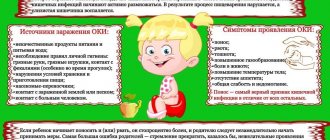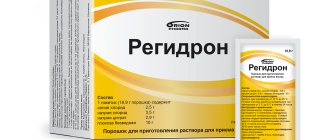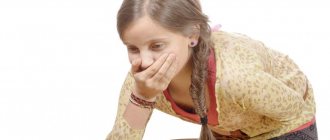When a child is sick, parents cannot find a place for themselves; they do not know how to alleviate the baby’s condition, what needs to be done, how to help. Nausea is most often accompanied by vomiting; this condition occurs for various reasons. This could be food poisoning, stomach problems, or traumatic brain injury. Before starting treatment, you should find out the reason for this reaction of the body.
Boy in black and white
Mechanism of vomiting
Vomiting is a physiological process in a child’s body, which is a defensive reaction. The body thus gets rid of toxicity. Signals for vomiting come from the cerebral cortex, liver, stomach and other organs. There is an eruption of partially digested or poorly digested pieces of food with a mixture of gastric juice or bile through the mouth.
Vomiting attacks can be repeated. The more often they occur, the higher the degree of dehydration, because the body loses a large amount of fluid with vomit. Often, after 1-2 attacks, the condition improves, toxins are eliminated, and the symptoms of nausea stop.
Important! For children under 2 years of age, dehydration occurs after 1-2 attacks.
It can cause serious damage to children's health.
Why does a child often feel sick and periodically?
Vomiting in a child without fever
The child may vomit frequently and periodically. This is due to different types of problems. If the baby has frequent attacks, it is most likely poisoning. If periodic, there is a stomach problem or neurological damage. The condition also occurs with or without fever. This is an important symptom when determining the cause.
Mom and baby
Prevention of conditions that provoke vomiting in children
Prevention of conditions that provoke vomiting in children is as follows:
- Compliance with personal hygiene rules.
- Avoid consumption of expired food products or those with improper storage conditions.
- Periodic treatment of all toys used by the child.
- Timely vaccination of the child.
- Control over the child (you cannot leave the child unattended).
- Medicines, household chemicals, and batteries should not be within the child’s reach.
Causes of vomiting and nausea in a child
Vomiting, diarrhea and fever in a child
The causes of nausea and vomiting in a child can be anything. Common symptoms in children include:
- Helminthiases. Children often come into contact with stray cats or dogs and do not always wash their hands and fruits thoroughly. Therefore, the penetration of helminthic infestations into the stomach often happens. Worms begin to grow inside the intestines and cause periodic vomiting without fever. The child loses weight, becomes less active, refuses to eat, and sometimes complains of a rash.
- Pyloric spasm. It happens in infants up to a year old, since it is not yet fully formed. This is why vomiting often occurs. Over time, children simply outgrow this problem.
- Intestinal obstruction. Happens at different ages. Requires urgent surgical intervention. The child feels sick for several days in a row, has periodic attacks, and has a low temperature. Vomit may contain bile. Occurs when there is a blockage with a ball of helminths or movement of part of the intestine and blocking the patency.
- Entry of a foreign body into the intestine. Often occurs in young children under 5 years of age. They eat objects out of great interest. The baby vomits periodically, complains of abdominal pain, and refuses to eat. At best, he can admit that he ate something. Vomit may be mixed with blood, as the foreign body scratches the esophagus.
- Rotovirus infection. Almost every person has encountered this virus. Frequent and simultaneous attacks of diarrhea and vomiting occur. The high temperature rises to 400. The child is weakened, drowsy, it is difficult for him to talk, he refuses food and active games. The disease lasts 3-5 days and requires medical intervention.
- Dysbacteriosis. It happens after treatment with a course of antibiotics. Medicines affect not only pathogenic microorganisms, but also destroy beneficial microbes. Because of this, the functionality of the intestines is disrupted, diarrhea and vomiting occur.
- The occurrence of acute gastritis, cholecystitis, gastroduodenitis, pancreatitis. Accompanied by vomiting, nausea, severe abdominal pain. The baby is worried, breathing heavily, and his temperature is rising. The child is constantly sick. You need to see a doctor.
- Traumatic brain injuries. After a fall or blow to the head, the baby experiences a disorder of the vestibular system. He feels dizzy, drowsy, periodically vomits, and loses his appetite.
- Food poisoning. Usually lasts about a day due to eating a low-quality product or one that has expired. An attack of diarrhea, nausea, and vomiting occurs. After bowel movement, relief occurs.
- Diseases associated with metabolic disorders. With undetected diabetes mellitus and lactose intolerance, vomiting occurs. Such conditions are treated only after examination and determination of the cause.
- Stressful condition. Occurs rarely, it happens in children who are very worried. For example, visiting someone for the first time, divorce and quarrels between parents, death of a loved one.
Important! If a child complains of nausea, then you should know what he ate before, what he was doing, what he was playing and under what circumstances. Reconstructing the full picture will help you quickly understand the cause of the condition.
Doctors are looking at the baby
Penetration of a foreign body into the stomach
A child at this age tries to taste everything by heart, so often some object ends up in the stomach. What to do if a child feels sick for this very reason? When swallowing a large object, discomfort most often occurs. This occurs due to spasm of the smooth muscles of the stomach.
In this case, the baby begins to vomit undigested food with mucus or blood. Sometimes rapid breathing and excessive salivation may occur. If you notice such symptoms, you should immediately consult a doctor. Waiting in this case, much less self-medicating, is categorically not recommended.
In addition to other causes, nausea in a child can also occur with:
- stress;
- developing dehydration;
- panic;
- allergies;
- taking medications, antibiotics;
- Gilbert's syndrome, etc.
What to do when vomiting and nausea is not recommended
Temperature 39 in a child under 1 year old
Some inexperienced parents make mistakes when their child is nauseous - they give the wrong medications and force them to eat. What not to do in such situations:
- force to eat;
- give sweet compotes and carbonated drinks to drink;
- offer candy;
- demand that the baby eat some dairy products;
- insist on the child’s activity;
- treat with little-known drugs;
- put the baby on his stomach;
- bathe in a hot bath.
Any of the above actions is prohibited in relation to the baby. This will only make the condition worse. Moreover, for children under one year of age and older, treatment tactics vary.
Ways to eliminate vomiting
Children under one year old are very fragile, and it is easy to disrupt the functioning of their body. They are just beginning to taste everything around them, gain certain knowledge, many of them through the mouth. Babies constantly put various objects and toys into their mouths. Therefore, the risk of rotavirus infection is high. What to do if a child under one year old is sick:
- first of all, you need to make sure that he lies on his side, since at this age children can choke on vomit;
- carry the baby in a column for some time, this prevents attacks;
- call a doctor to your home for an examination;
- take the temperature;
- give the baby water to drink;
- if vomiting is frequent, give lightly salted water;
- If the doctor is traveling for a long time, then you can dilute a little smecta, but strictly according to the instructions.
A medical consultation will help establish proper nutrition for the period of illness, tell you about contraindications and treatment methods. Self-medication is dangerous for the child’s life.
The girl has a stomach ache
When you can't do without anti-vomiting pills
If the child is constantly nauseous, then antiemetics are given. They are prescribed by a doctor, as some of them have a number of side effects. If the nausea has been going on for several days, the child complains of abdominal pain and the inability to eat normally, then they start taking pills.
Contraindications to taking medications
In some situations, a child is prohibited from taking medications for nausea and vomiting. This occurs when the cause of the condition is unknown or there is an allergic reaction to the components of the drug. In such cases, the baby is taken to the hospital, examined, diagnosed and the necessary treatment is selected.
Important! The dosage and correct treatment regimen are selected by the doctor after the examination.
Food and drink
When a child complains of nausea, this indicates that he is sick with something. This condition is associated with loss of appetite; it is worth reviewing your diet during illness. If the attacks are repeated and do not stop, then during this time it is recommended to give lightly salted water or still mineral water to drink. Until he gets better, they don’t let him eat. When a child vomits periodically, they give dishes from the list:
- infants continue to be fed with formula or breast milk;
- Children under one year of age continue to be given complementary foods, but preferably vegetable ones;
- adult babies are given viscous porridge;
- unsweetened tea, water;
- vegetable soups;
- boiled meat or low-fat fish.
They try to add minimal salt to food so as not to cause intestinal inflammation. Monitor the child's reaction to its use. If it gets worse, then switch to more liquid food.
Important! It is prohibited to give children smoked meats, spices, sweets and other unhealthy foods.
Girl covers her mouth with her hands
Medicines
Among medications, sorbents can be distinguished (the cheapest and most famous is activated carbon; Smecta, Enterosgel, Filtrum or Laktofiltrum are effective). They prevent toxins from leaving the digestive tract and calm it. In case of severe pain, you are allowed to take antispasmodics (Drotaverine, No-shpa). Before taking, you should carefully study the instructions. It is worth understanding that anti-vomiting medications for a 3-year-old child are significantly different from those given to children 4, 6 and 7 years old.
Instead of water, you can drink weak green or mint tea, diluted with honey. They will help calm the internal organs, and the baby will stop vomiting. If you are vomiting with bile, then it is better not to use mint in bags, but leaf mint, pour boiling water over it and infuse it.
Traditional medicine recommends drinking water with dill for nausea and vomiting. A teaspoon of dill fruits or leaves should be diluted with 200 ml of boiling water. You need to leave for 10-15 minutes, then keep in a water bath for half an hour. Give small children a teaspoon to drink, and older children two spoons.
Read also What to do if a child is poisoned and vomits: first aid
Even after the condition improves, the baby should be kept in bed, continuing to drink tinctures and monitor changes. For some time after vomiting, the child will refuse food, this is natural. In this case, there is no need to force you to eat.
When emergency help is required
In some cases, a child may require emergency medical attention if the vomiting is due to a serious illness and requires medical attention. Main symptoms:
- the presence of blood in the vomit;
- severe abdominal pain;
- drowsiness;
- chills;
- heat;
- vomit is thick and black;
- admixture of bile;
- dizziness;
- recent injury;
- smell of acetone from the mouth;
- dry skin;
- loss of consciousness;
- frequent attacks in the form of fountains.
Such symptoms appear after a traumatic brain injury, inflammation in the internal organs, chemical poisoning, or the development of diabetes mellitus. It's better to play it safe once again.
Important! If the vomit has an uncharacteristic color and consistency, you should immediately call an ambulance.
Diagnostics
The classification of vomiting will help determine the baby’s condition. Depending on the cause, vomit may vary in appearance, color and smell. These are all very important characteristics that should be pointed out to your doctor.
- An admixture of blood (vomit in the form of coffee grounds or scarlet color) requires an immediate call for an ambulance! This symptom indicates bleeding in the upper digestive tract. Scarlet color is characteristic of damage to the esophagus and stomach. “Coffee grounds” for both stomach and duodenal diseases. The symptom manifests itself in case of poisoning with poisons, mushrooms, peptic ulcers, or ingestion of foreign bodies. There have been cases where the esophagus was damaged when children abused chips! Ulcers and erosions formed as a consequence of acute poisoning.
- An admixture of bile (a mass of greenish or yellowish tint) is quite rare. It occurs as a reaction to overeating spicy, fatty foods and poisoning.
- Mucous impurities are the most common. In infants, this is a normal option, since they often overeat, and natural lubricant from the bronchi and nasopharynx can get into the vomit. In older children, this may indicate gastritis, drug poisoning, rotavirus infection, or food poisoning. Less commonly, mucous vomit is a sign of a disease of the central nervous system.
Actions before the doctor arrives
Until the doctor arrives, parents help the child with nausea at home. These are simple procedures that will help the doctor quickly provide assistance and understand the problem:
- The child is placed on his side so that he does not choke on his own vomit. This is especially true for children under 3 years of age.
- Change into clean and well-breathable clothes to prevent sweating.
- They are trying to give the baby water to drink until the doctor arrives.
- Measure your temperature yourself.
Such actions will help the doctor to comfortably conduct an examination and prescribe treatment. The main thing is not to panic and prepare properly.
The girl is vomiting
How to help
First of all, parents should calm down and be sure to call an ambulance. Seeing a doctor is especially important in case of bloody vomit, when time can count in minutes.
Then adults should provide first aid:
- The baby is calmed down and placed on a bed previously covered with a diaper or sheet. A basin or plastic bucket is placed nearby. Infants must be kept upright! At the same time, the mother throws a diaper over her shoulder and holds cloth napkins in her hands to wipe the baby’s face.
- One of the main dangers in such a situation is the rapid loss of vital moisture. To prevent dehydration, children are given chilled boiled water from a pipette or teaspoon. Children over one year old drink from a cup, but in small sips and small portions. To maintain the water-salt balance, it is better to give alkaline mineral water or dissolved Rigedron powder.
- If blood is present, do not give any drink! Until the ambulance arrives, the child is offered only small pieces of ice, and a cool heating pad is placed on the stomach. This will help stop the bleeding that has started (the blood vessels will narrow).
- After each urge to vomit, it is necessary to wash your face and rinse your mouth, since bile and gastric juice can irritate the skin.
- It is prohibited to give any medications without a doctor's prescription!
- You should also not feed the baby.
Listen to the recommendations and advice of a pediatrician:
Recommendations for a speedy recovery
The vomiting stops sooner or later. There are some useful tips for a speedy recovery:
- Strictly follow the doctor's recommendations.
- Increase the child's drinking regime.
- Make your baby’s diet healthier during treatment.
- Take all necessary medications.
- Temporarily limit children's activity.
- Do not give sweets and fruits.
Nausea and vomiting in a child look scary in the eyes of parents. The most common cause of this disease is poisoning. Adults are responsible for monitoring the freshness and quality of food given to children. Their gastrointestinal tract is less developed, which is why rejection occurs more often. In addition to poisoning, children may vomit due to health problems, after a head injury, and due to metabolic disorders.
What to do next
As soon as the vomiting has stopped and the child’s well-being has improved, it is necessary to provide all the conditions for recovery.
At the first stage, nutrition is regulated and sufficient consumption of clean water is ensured. Jelly, mucous soups or chicken broth should be administered. Food is provided often, but in small portions. After a day, the menu can be expanded with rye crackers or drying.
The fluid requirement in the first 10 hours is 60 ml per baby’s current weight. Then the rate decreases to 10 ml. Additionally, you can give rosehip decoction and herbal teas.
All spicy, sweet, fatty, salty and smoked dishes are excluded from the menu. You should not eat raw vegetables and fruits for at least two to three days.
If you follow all the above rules, recovery will occur as soon as possible. It is recommended to visit a pediatrician even if the baby was treated at home. Multiple vomiting and the presence of bile should be especially alarming. Bloody vomit is an indication for urgent hospitalization!











